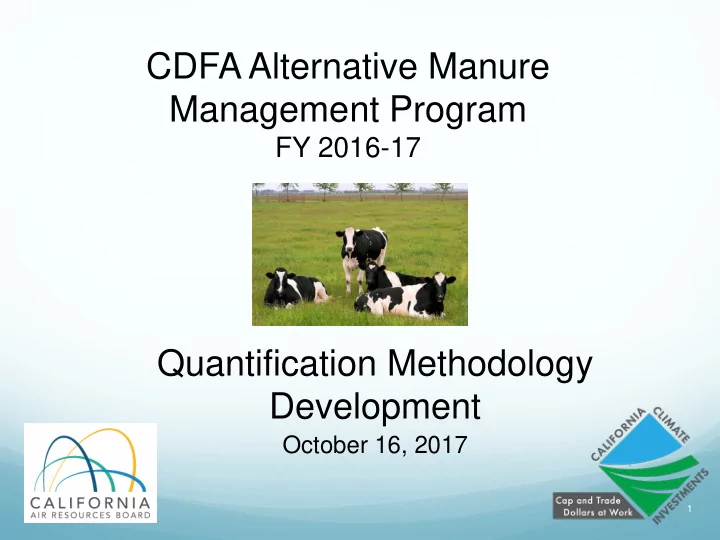

CDFA Alternative Manure Management Program FY 2016-17 Quantification Methodology Development October 16, 2017 1
Overview of Presentation CARB’s role in CDFA’s Alternative Manure Management Program (AMMP) Quantification Methodology (QM) Development Approach Eligible Project Types and Approaches Areas of Improvement & Upcoming Contract Work 2
California Air Resources Board’s Role in CDFA’s Alternative Manure Management Program CARB required by statute to develop QM for Greenhouse Gas Reduction Fund (GGRF) projects QMs provide a mechanism to estimate the net GHG benefits from project implementation Net GHG benefits result from: Avoided CH4 emissions from reduced anaerobic storage of dairy/livestock manure Impact of fossil fuel use changes associated with new manure management practices CARB staff from other divisions participate in interagency Technical Advisory Committee (TAC) that reviews AMMP project applications 3
AMMP QM Development Greenhouse Gas Reduction Fund Principles Applies at the project-level Aligns with the project types proposed for funding Estimates GHG benefits from direct, onsite practices Based on scientifically sound, peer-reviewed methods Other considerations New program for FY 2016-17 Accelerated timeline for QM development Reliance on existing, peer-reviewed literature and established (CARB Board approved) methods 4
AMMP QM Development Decision to adapt the CARB Compliance Offset Protocol for Livestock Projects for the AMMP program Vetted through regulatory process Uses widely accepted methods Though designed for digester projects, contains models and equations applicable to quantifying AMMP projects Provides consistency with approach used in CDFA’s Dairy Digester Research and Development Program (DDRDP) https://www.arb.ca.gov/cc/capandtrade/protocols/livestock/livestock.htm 5
AMMP QM Development California Climate CARB Offset Program Investments Incentive program Regulatory compliance mechanism Pre-project estimation Post-project measurements In developing AMMP QM and GHG Calculator Tool, CARB considered: Minimizing complexity for applicants Balancing ease of use with flexibility Default assumptions vs project-specific inputs 6
Project Boundary Includes CH4 emissions associated with manure treatment/storage Anaerobic lagoons, storage ponds, manure settling basins, dry lot deposits, compost piles, solid storage piles, etc . Fossil fuel emissions associated with manure management, transport & storage Excludes Carbon sequestration of manure applied to land N2O accounting 7
Eligible Project Types and Approaches Eligible project types Initial list developed by CDFA CARB evaluated practices 1. To ensure they achieve net GHG reductions 2. Determine availability of reliable GHG methods and/or factors General approach Account for where manure is deposited and/or stored % deposited on land & not collected, % entering wet/anaerobic system, % composted, etc. Determine methane production associated with each treatment/storage practice Methane conversion factor (MCF) 8
Eligible Project Types and Approaches 1. Pasture-based management i. Conversion of a non-pasture livestock operation; ii. Increasing the amount of time livestock spend at pasture; and/or iii. Construction of a compost bedded pack barn. 2. Solid separation in conjunction with: a) Open solar drying ; b) Closed solar drying ; c) Forced evaporation with natural-gas fueled dryers ; d) Daily spread ; e) Solid Storage ; f) Composting in vessel ; g) Composting in aerated static pile ; h) Composting in intensive windrows ; or i) Composting in passive windrows . 3. Conversion from flush to scrape manure collection in conjunction with one of (a) through (i). 9
Project Types Not Included in QM – Further Evaluation Needed Gasification and/or pyrolysis Need to better understand and evaluate technology(ies) GHG quantification challenges Net energy balance Potential criteria/toxics impacts Aerobic treatment & biological treatment Broad range of potential technologies or practices Need to evaluate specific practices Effectiveness in reducing CH4 emissions (measurements needed) Required energy inputs Potential impacts on nitrous oxide and ammonia 10
Eligible Project Types and Approaches Default Factors 1. % manure deposited on land and not collected Derived based on where cows spend their time Median values used from ranges available in 2003 UC Davis study 20% for dairy cows in freestalls 70% for dairy cows in open-lot corrals, dry cows and heifers 90% for lactating dairy cows at pasture 2. Solid separation efficiency defaults from Livestock Protocol 3. Scrape conversion default assumes milking parlors still flushed (90% scrape collection efficiency) 11
AMMP GHG Calculator Tool User friendly Complex formulas built into Tool applicants only input project information Drop-down selections for most inputs Default values provided but allows flexibility for use of project specific factors when justified 12
AMMP GHG Calculator Tool 13
AMMP GHG Calculator Tool 14
AMMP GHG Calculator Tool 15
AMMP GHG Calculator Tool 16
Potential Areas of Improvement CARB is in process of contracting with the University of California for technical assistance to update the QM and GHG Calculator Tool Identified priority areas: 1. Evaluation of default assumptions regarding manure deposited on land and not collected 2. Review existing default factors for solid separation efficiency and recommend additional factors if possible 17
Potential Areas of Improvement 3. Evaluation of weeping wall solid separation systems Refine volatile solid separation efficiency and methane conversion factor 4. Evaluation of additional manure management practices for potential inclusion in AMMP Gasification and/or pyrolysis Aerobic treatment (aeration/oxygenation) 18
Process for Updating QM Opportunity to update AMMP QM for FY 2017-18 Need peer-reviewed or Board-approved methods and data FY 2017-18 GGRF programs also on accelerated timeline Please send us suggestions and data for consideration in updating the AMMP QM and GHG Calculator Tool 19
Contacts Quantification Methodologies and GHG Calculator Tools for GGRF programs available at: www.arb.ca.gov/cci- quantification Contact us at: GGRFprogram@arb.ca.gov Erik Winegar: erik.winegar@arb.ca.gov Climate Investments Assessment Section Bonnie Soriano: bsoriano@arb.ca.gov Supervisor, Climate Investments Assessment Section 20
Recommend
More recommend